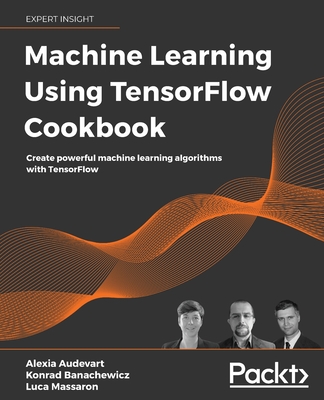The Deep Learning with Keras Workshop: Learn how to define and train neural network models with just a few lines of code
暫譯: Keras 深度學習工作坊:學習如何用幾行程式碼定義和訓練神經網絡模型
Moocarme, Matthew, Abdolahnejad, Mahla, Bhagwat, Ritesh
- 出版商: Packt Publishing
- 出版日期: 2020-07-28
- 售價: $1,650
- 貴賓價: 9.5 折 $1,568
- 語言: 英文
- 頁數: 496
- 裝訂: Quality Paper - also called trade paper
- ISBN: 1800562969
- ISBN-13: 9781800562967
-
相關分類:
DeepLearning
海外代購書籍(需單獨結帳)
商品描述
Discover how to leverage Keras, the powerful and easy-to-use open source Python library for developing and evaluating deep learning models
Key Features
- Get to grips with various model evaluation metrics, including sensitivity, specificity, and AUC scores
- Explore advanced concepts such as sequential memory and sequential modeling
- Reinforce your skills with real-world development, screencasts, and knowledge checks
Book Description
New experiences can be intimidating, but not this one This beginner's guide to deep learning is here to help you explore deep learning from scratch with Keras, and be on your way to training your first ever neural networks.
What sets Keras apart from other deep learning frameworks is its simplicity. With over two hundred thousand users, Keras has a stronger adoption in industry and the research community than any other deep learning framework.
The Deep Learning with Keras Workshop starts by introducing you to the fundamental concepts of machine learning using the scikit-learn package. After learning how to perform the linear transformations that are necessary for building neural networks, you'll build your first neural network with the Keras library. As you advance, you'll learn how to build multi-layer neural networks and recognize when your model is underfitting or overfitting to the training data. With the help of practical exercises, you'll learn to use cross-validation techniques to evaluate your models and then choose the optimal hyperparameters to fine-tune their performance. Finally, you'll explore recurrent neural networks and learn how to train them to predict values in sequential data.
By the end of this book, you'll have developed the skills you need to confidently train your own neural network models.
What you will learn
- Gain insights into the fundamentals of neural networks
- Understand the limitations of machine learning and how it differs from deep learning
- Build image classifiers with convolutional neural networks
- Evaluate, tweak, and improve your models with techniques such as cross-validation
- Create prediction models to detect data patterns and make predictions
- Improve model accuracy with L1, L2, and dropout regularization
Who this book is for
If you know the basics of data science and machine learning and want to get started with advanced machine learning technologies like artificial neural networks and deep learning, then this is the book for you. To grasp the concepts explained in this deep learning book more effectively, prior experience in Python programming and some familiarity with statistics and logistic regression are a must.
商品描述(中文翻譯)
探索如何利用 Keras,這個強大且易於使用的開源 Python 函式庫來開發和評估深度學習模型
主要特點
- 掌握各種模型評估指標,包括靈敏度、特異性和 AUC 分數
- 探索進階概念,如序列記憶和序列建模
- 透過實際開發、螢幕錄影和知識檢查來加強你的技能
書籍描述
新的體驗可能會讓人感到畏懼,但這本書不會。這本針對初學者的深度學習指南將幫助你從零開始探索深度學習,並開始訓練你的第一個神經網絡。
Keras 與其他深度學習框架的不同之處在於其簡單性。擁有超過二十萬的用戶,Keras 在業界和研究社群中的採用率高於任何其他深度學習框架。
《使用 Keras 的深度學習工作坊》首先介紹使用 scikit-learn 套件的機器學習基本概念。在學習如何執行建立神經網絡所需的線性轉換後,你將使用 Keras 函式庫建立你的第一個神經網絡。隨著進步,你將學會如何建立多層神經網絡,並識別模型是否對訓練數據過擬合或欠擬合。在實際練習的幫助下,你將學會使用交叉驗證技術來評估模型,然後選擇最佳的超參數來微調其性能。最後,你將探索遞迴神經網絡,並學習如何訓練它們以預測序列數據中的值。
在本書結束時,你將具備自信訓練自己的神經網絡模型所需的技能。
你將學到什麼
- 深入了解神經網絡的基本原理
- 理解機器學習的限制以及它與深度學習的區別
- 使用卷積神經網絡建立圖像分類器
- 使用交叉驗證等技術評估、調整和改進你的模型
- 創建預測模型以檢測數據模式並進行預測
- 透過 L1、L2 和 dropout 正則化提高模型準確性
本書適合誰
如果你了解數據科學和機器學習的基本知識,並希望開始使用像人工神經網絡和深度學習這樣的進階機器學習技術,那麼這本書就是為你而寫的。為了更有效地掌握本書中解釋的深度學習概念,必須具備 Python 編程的先前經驗以及對統計和邏輯回歸的基本了解。
作者簡介
Matthew Moocarme is a director and senior data scientist in Viacom's advertising science team. As a data scientist at Viacom, he designs data-driven solutions to help Viacom gain insights, streamline workflows, and solve complex problems using data science and machine learning. Matthew lives in New York City and outside of work enjoys combining deep learning with music theory. He is a classically-trained physicist, holding a Ph.D in physics from The Graduate Center of CUNY and is an active artificial intelligence developer, researcher, practitioner, and educator.
Mahla Abdolahnejad is a Ph.D. candidate in systems and computer engineering with Carleton University, Canada. She also holds a bachelor's degree and a master's degree in biomedical engineering, which first exposed her to the field of artificial intelligence and artificial neural networks, in particular. Her Ph.D. research is focused on deep unsupervised learning for computer vision applications. She is particularly interested in exploring the differences between a human's way of learning from the visual world and a machine's way of learning from the visual world, and how to push machine learning algorithms toward learning and thinking like humans.
Ritesh Bhagwat has a master's degree in applied mathematics with a specialization in computer science. He has over 14 years of experience in data-driven technologies and has led and been a part of complex projects ranging from data warehousing and business intelligence to machine learning and artificial intelligence. He has worked with top-tier global consulting firms as well as large multinational financial institutions. Currently, he works as a data scientist. Besides work, he enjoys playing and watching cricket and loves to travel. He is also deeply interested in Bayesian statistics.
作者簡介(中文翻譯)
**馬修·穆卡梅**是維亞康廣告科學團隊的主任和高級數據科學家。作為維亞康的數據科學家,他設計數據驅動的解決方案,幫助維亞康獲取洞察、簡化工作流程,並利用數據科學和機器學習解決複雜問題。馬修居住在紐約市,工作之餘喜歡將深度學習與音樂理論結合。他是一位受過古典訓練的物理學家,擁有CUNY研究生中心的物理學博士學位,並且是一位活躍的人工智慧開發者、研究者、實踐者和教育者。
**馬哈拉·阿卜杜拉赫賈德**是加拿大卡爾頓大學系統與計算機工程的博士候選人。她擁有生物醫學工程的學士和碩士學位,這使她首次接觸到人工智慧及人工神經網絡的領域。她的博士研究專注於計算機視覺應用的深度無監督學習。她特別感興趣於探索人類從視覺世界學習的方式與機器從視覺世界學習的方式之間的差異,以及如何推動機器學習算法朝向像人類一樣學習和思考。
**瑞特什·巴格瓦特**擁有應用數學碩士學位,專攻計算機科學。他在數據驅動技術方面擁有超過14年的經驗,並參與過從數據倉儲和商業智能到機器學習和人工智慧的複雜項目。他曾與頂尖的全球諮詢公司以及大型跨國金融機構合作。目前,他擔任數據科學家。除了工作,他喜歡打板球和觀看板球,並熱愛旅行。他對貝葉斯統計也有濃厚的興趣。
目錄大綱
- Introduction to Machine Learning with Keras
- Machine Learning versus Deep Learning
- Deep Learning with Keras
- Evaluating your Model with Cross-Validation Using Keras Wrappers
- Improving Model Accuracy
- Model Evaluation
- Computer Vision with Convolutional Neural Networks
- Transfer Learning and Pre-Trained Models
- Sequential Modeling with Recurrent Neural Networks
目錄大綱(中文翻譯)
- Introduction to Machine Learning with Keras
- Machine Learning versus Deep Learning
- Deep Learning with Keras
- Evaluating your Model with Cross-Validation Using Keras Wrappers
- Improving Model Accuracy
- Model Evaluation
- Computer Vision with Convolutional Neural Networks
- Transfer Learning and Pre-Trained Models
- Sequential Modeling with Recurrent Neural Networks






























